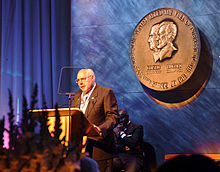Career
After college, Cepollina worked for Aerojet General Corp. for four years, followed by the Defense Intelligence Agency. [2] [3] In 1963, he accepted a position with NASA's Goddard Space Flight Center. [2] [5]
With NASA, he worked on the Advanced Orbiting Solar Observatory, which was canceled in 1965 before being launched. [4] Next, he worked on the Orbiting Astronomical Observatory program. [4] In the 1970s, he began working with the Hubble Space Telescope. [3] Cepollina also worked on the Multimission Modular Spacecraft program which built six science satellites in the 1970s and 1980s. [4] This included the Solar Maximum Mission, Landsats 4, Landsats 5, the Upper Atmosphere Research Satellite, and the Extreme Ultraviolet Explorer. [4]
The first modular craft to fly was the Solar Maximum Mission satellite, launched in 1980 to conduct astronomical sun observations. [6] When it began to fail several months into orbit, Cepollina led the repair mission, which began in 1984. The mission was successful, and the modular craft concept proved effective. Cepollina was subsequently named Satellite Servicing Project Manager. [1]
Cepollina was tasked with repairing the Hubble Space Telescope. Having worked on the development of its modular design, as well as its command and control subsystem, Cepollina knew the Hubble's systems well, and the issue was later identified as 375 miles above Earth- a flawed mirror. [7] NASA discovered that this had been caused by a miscalculation which made the telescope incapable of focusing sharply. [8]
Cepollina led other repair and improvement missions for Hubble in 1997, 1999, 2002, and 2009. [3] These added newer technologies such as improved cameras, solar arrays, and improved processors. [2] He became the Deputy Associate Director for the Hubble Space Telescope Development Project. [1] In 2000, he received the rank of Meritorious Executive in Senior Executive Service for his outstanding accomplishments in managing NASA programs. [3] He retired from NASA on January 3, 2017. [9]
His work has led to developments in other industries, including a method of detecting breast cancer, as well as more powerful microchips that used Hubble-type optics and manufacturing applications employing an intelligent, programmable, hand-held power tool. [2] [3] [10]
This page is based on this
Wikipedia article Text is available under the
CC BY-SA 4.0 license; additional terms may apply.
Images, videos and audio are available under their respective licenses.
